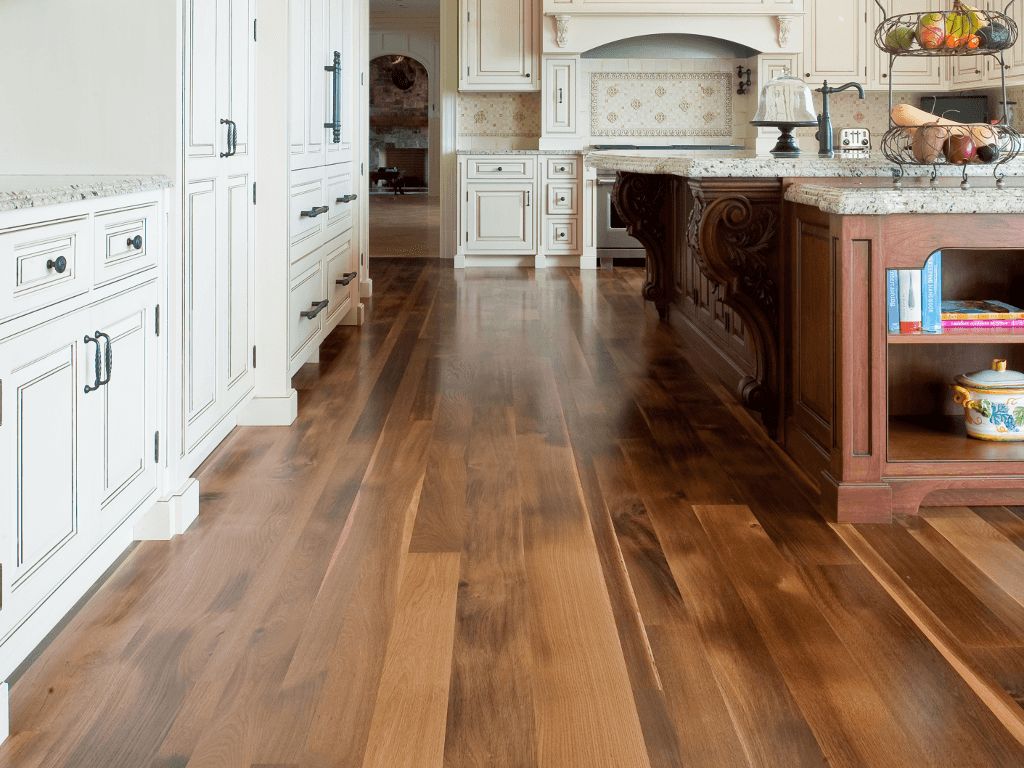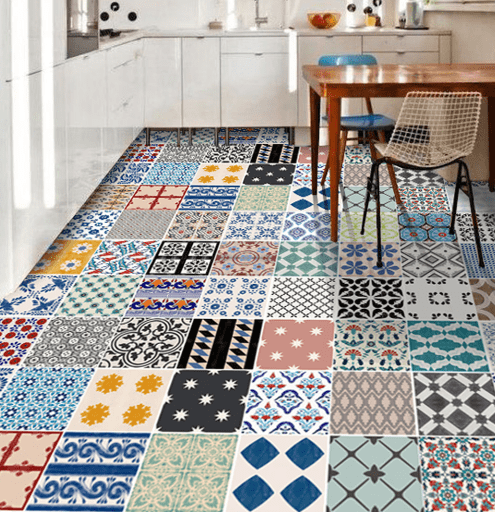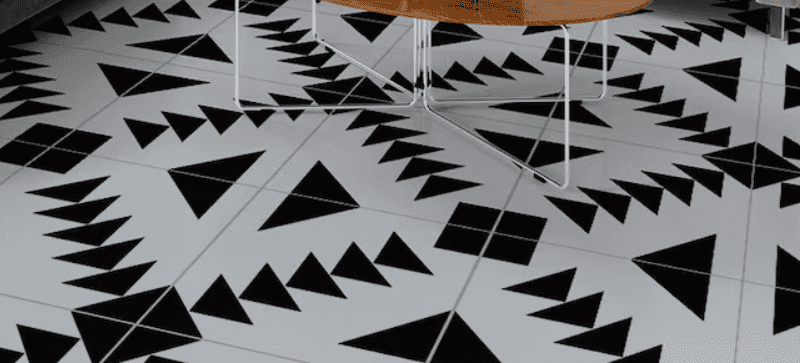Revamping kitchen floors often involves cumbersome tile removal, but now there are innovative methods that allow for updates without the need to remove your old tiles.
This guide covers options such as vinyl overlays, grout renewal, and specialized coatings. We will look at practical, cost-effective solutions that promise aesthetic enhancement and minimal disturbance, perfect for those wanting a new look without a full renovation.
Discover how to transform your kitchen flooring with ease and efficiency.
Points To Note
- The strategies described offer homeowners inventive and practical methods for updating kitchen floor tiles without the need for removal. Approaches such as applying vinyl overlays, refreshing grout, and using strategic coverings are cost-efficient and customizable options that improve the appearance of kitchen spaces.
- Employing these strategies will result in minimal disruption and support a swift change from outdated flooring to attractive surfaces that complement contemporary kitchen styles.
Even though this video is from the USA but, it’s actually has some good ideas.
Assessing the Situation
Evaluate the condition of your existing kitchen floor tiles to determine the most suitable update method without removal.
Start by checking the tiles for any cracks, chips, or significant wear that might affect the adhesion of new surface treatments. If the existing tiles are stable, consider using paint specifically formulated to bond with ceramic or porcelain surfaces, ensuring a long-lasting finish.
To refresh grout lines, use a strong grout cleaner to eliminate accumulated dirt and stains, bringing back the original color and preventing further decay.
For a broader change, covering tiles with a new material like vinyl flooring offers an extra layer of design while keeping the underlying tiles intact. Precise measurement and cutting are important for a seamless installation.
Vinyl Flooring Installation
After assessing the stability and condition of your existing kitchen tiles, you can choose vinyl flooring as a versatile and waterproof option that installs directly over your old tiles.
The process involves cleaning the existing floor to ensure the vinyl sticks properly. When selecting new flooring, consider the thickness of the vinyl to manage height differences at thresholds.
To install, measure the area precisely, and cut the vinyl to fit the space, leaving a slight excess which can be trimmed off later. Position the vinyl carefully, gradually peeling back the adhesive layer to cover the existing tiles. Use a roller to eliminate air pockets and ensure a strong adherence between the vinyl and the tiles underneath.
Utilizing Rugs and Carpets
Incorporating rugs and carpets is a simple yet effective approach for revamping the look of old kitchen floor tiles without needing to remove them. By strategically positioning rugs or using modular carpet tiles, homeowners can conceal unsightly tiles and introduce a touch of modernity or a warm atmosphere to the area.
This strategy does not only improve the look of existing floors but also adds a layer of comfort underfoot. When choosing a covering, opt for materials that are robust and simple to maintain, considering the kitchen’s high chance of spills.
The adaptability of carpet tiles permits personalization and straightforward swapping of sections when needed, while larger rugs can create a consistent appearance across a wider space.
This method is both practical and economical for refreshing kitchen floor tile designs.
Laminated Wooden Flooring
Transitioning to laminated wooden flooring offers a durable and aesthetically pleasing solution to update kitchen floor tiles without the need for removal. This method involves installing wooden cladding over existing flooring, effectively hiding outdated or worn tile floors.
Laminated flooring, known for its resemblance to natural wood, is produced by bonding synthetic materials with a laminate finish, making it a practical choice for indoor areas.
As a less expensive option compared to traditional hardwood, laminated flooring provides cost savings without sacrificing style. When updating kitchen tiles, this approach reduces labor and material costs, as it avoids the need to dismantle the existing tile work.
Laminated wooden flooring is also lightweight, easy to maintain, and brings a sense of warmth to the kitchen’s overall design.

Epoxy Coating Application
Applying an epoxy coating offers homeowners a long-lasting and visually attractive option to update their kitchen floor tiles without the need to remove them. This method involves a series of steps that cover old tiles with specialized tile paint, giving a new, glossy surface. Epoxy coating application demands meticulous preparation and precision to ensure a lasting and even outcome.
- Surface Preparation: Clean the kitchen floor meticulously to eliminate any grease, dirt, or previous sealers that might hinder the epoxy’s adhesion.
- Epoxy Mixing: Follow the manufacturer’s guidelines to mix the epoxy resin and hardener for the right consistency and durability.
- Application: Spread the epoxy coating uniformly over the old tiles, using a roller or brush made for epoxy paint to get a glossy and even surface.
Deep Cleaning Tile Grout
A homeowner’s guide to deep cleaning tile grout includes using specialized cleaners or a combination of baking soda and vinegar to effectively lift accumulated dirt and bring back the grout’s bright color. This detailed process is vital for upholding the look and cleanliness of ceramic tile floors.
To carry out a complete clean:
- Spread a grout-specific cleaning agent or create a mix of baking soda and water, then spritz with vinegar.
- Employ a stiff-bristled brush to rigorously scrub the grout lines, making sure to clear away all trapped dirt.
- Wash the area with fresh water and dry well to avoid any leftover residue or dampness from getting back into the grout pores.
This careful method ensures that the deep cleaning of grout aids in an overall refreshed look of the flooring.
Applying Tile Stickers
For homeowners wanting a swift and economical method to update their space, tile stickers are an inventive option to refresh kitchen floors without removing the old ones. These sticky overlays are made to attach to your existing floor tiles, providing an instant makeover to any kitchen backsplash or floor area. The application demands precise cleaning of the current tiles for a strong grip and exact alignment of the stickers to achieve a cohesive look.
| Step | Detail | Tips |
|---|---|---|
| Surface Preparation | Clean and dry the existing floor tiles | Use gentle detergent; avoid leaving soap residue |
| Alignment | Measure and plan sticker layout | Use a ruler for exact positioning |
| Application | Peel and stick onto the current tiles | Use a flat tool to press out air bubbles |
| Finishing Touches | Cut off extra material | A sharp blade will ensure neat edges |
| Maintenance | Clean regularly with a soft cloth | Stay away from strong cleaners to maintain stickiness |
Following these instructions, you can refresh your kitchen tiles with tile stickers effectively, giving your space a renewed appearance with little interruption.

Painting Kitchen Tiles
Painting kitchen tiles is an alternative method for refreshing your kitchen floor’s appearance without the need to remove existing tiles. This option not only reduces time spent but also gives homeowners the opportunity to express their individual style in their home.
Consider the following when deciding to paint your floor tiles:
- Proper Surface Preparation: Make sure tiles are cleaned, repaired, and primed before applying paint to ensure strong adhesion and a beautiful finish.
- High-Quality Tile Paint: Choose specialty paints specifically made for tile use, which are durable enough to handle the activity of kitchen floors.
- Sealing the Paint: Use a clear urethane topcoat to shield the paint from moisture, scratches, and stains, which helps maintain the fresh look for an extended period.
Using Contact Paper
Shifting from reinvigorating grout lines, another inventive method to refresh kitchen tiles without removal is using contact paper. This adaptable, temporary adhesive material can mimic an array of finishes and designs. Contact paper can swiftly alter the appearance of your kitchen floor to complement the style of your countertop and cabinets, presenting an economical and speedy makeover.
- Natural Stone Appearance: Contact paper is available in styles that replicate the look of natural stone, offering an upscale appearance without the expense and effort involved with real stone installation.
- Vinyl-Like Durability: High-quality contact paper can mirror the appearance of premium vinyl flooring, providing a resilient surface that endures the activity of a kitchen.
- Harmonizing Styles: Contact paper comes in a broad selection of designs, making it simple to match with your current kitchen theme, whether it’s contemporary or traditional.
Wood and Metal Paneling
For homeowners wanting to give their kitchen floors an elegant update, wood and metal paneling are contemporary choices that can be installed over existing tiles. Wood brings a cozy touch, adding warmth and natural texture, while metal paneling creates an industrial vibe with clean lines and reflective surfaces. These options not only refresh the kitchen’s look but also enhance its durability.
| Emotion Evoked | Paneling Choice |
|---|---|
| Warmth | Natural Wood |
| Modernity | Brushed Metal |
| Elegance | Polished Metal |
| Comfort | Distressed Wood |
| Boldness | Corrugated Metal |
When selecting wood or metal paneling, preparing the existing tile surface for proper adhesion is important. Both materials need accurate measurement and cutting to ensure a seamless installation. Always take the overall kitchen design into account to create a cohesive look.
Why Update Your Tiles?
Updating floor tiles without removing them not only enhances the kitchen’s look with wood or metal paneling but also offers significant savings and less interference with everyday activities. This method is especially advantageous for homeowners aiming to revitalize their space without the extensive and messy procedure of tile replacement. Here are some practical advantages:
- Cost Efficiency: Skips the cost of purchasing new tiles and the labor for their removal and installation.
- Time-Saving: Cuts out the prolonged period needed for tile removal, enabling a quicker makeover.
- Less Mess: Minimizes the dust and debris usually linked with tile replacement, which helps to maintain a tidier home during the renovation.
Choosing to update tiles without removing them allows homeowners to revamp their living space with reduced trouble and financial outlay.
Kitchen Remodel Planning
When planning a kitchen remodel, it is important to measure the scope of work, especially when you intend to update the floor tiles without removal. This ensures that the design and budget are in line with the renovation goals.
A comprehensive plan should include consideration of alternative materials and new techniques that can refresh the kitchen’s look without needing extensive demolition. Here are some practical points to consider:
- Evaluating the existing floor condition: Check whether the concrete base is stable or if any repairs are necessary before adding new materials.
- Selection of materials: Choose high-quality, durable wallpapers or vinyl that are suitable for kitchen use, and can withstand areas with high moisture levels.
- Design integration: Make sure that the updates you choose will blend well with the current kitchen cabinetry and fixtures, to create a uniform look.
Popular Questions
Can Updating Floor Tiles Without Removal Address Issues of Uneven or Damaged Tile Surfaces?
Updating damaged or uneven tile surfaces often requires removal, but specific resurfacing products might offer a leveled layer, though with some constraints based on how severe the underlying damage is. Seeking professional advice is recommended.
How Do I Ensure That the New Surface Treatment, Such as Stickers or Paint, Adheres Properly to Glossy or Glazed Tile Finishes?
To ensure a new surface treatment such as stickers or paint adheres properly to glossy or glazed tile finishes, clean the surface completely and gently sand it to create a rougher texture. Then apply primers that are specifically made for non-porous surfaces before adding the new treatment.
Are There Any Specific Precautions to Take When Updating Kitchen Floor Tiles Around Appliances and Plumbing Fixtures?
When updating floor tiles near appliances and plumbing fixtures, make sure the surfaces are clean and moisture-free. Be careful to prevent water damage or electrical problems. Adhere to the instructions provided by the manufacturers for materials that will be near heat sources.
How Does Foot Traffic and the Weight of Kitchen Furniture Affect the Longevity of Non-Removal Tile Update Methods?
High levels of foot traffic and the substantial weight of kitchen furniture can cause increased deterioration of surface treatments, making it necessary to use robust solutions like top-quality vinyl or epoxy coatings for updates to tiles that do not require removal.
What Are the Environmental Considerations to Keep in Mind When Choosing Materials for Updating Kitchen Tiles Without Removing Them?
When choosing materials for updating kitchen tiles without removing them, opt for environmentally friendly alternatives that reduce waste, like recyclable vinyl or biodegradable glues. Select products with low volatile organic compounds (VOCs) to maintain good indoor air quality during the application process.
Final Points
The methods discussed provide homeowners with inventive and practical ways to update kitchen floor tiles without removing them. Techniques such as vinyl overlays, grout renewal, and strategic coverings are cost-effective and customizable solutions that enhance the look of kitchen spaces.
Using these methods will cause minimal interruption and allow for a quick transformation of old flooring into attractive surfaces that suit modern kitchen designs.

